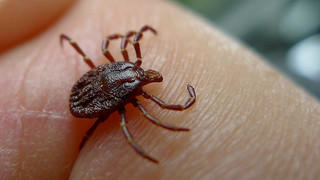Worried About Tick Diseases? There’s a Test For That
By Chris Williams on May 5, 2015.

If you’re not already worried about ticks biting your family and pets, you should be (see Look Out! Ticks Are Already Active!) and Springtime Means Tick Time!).
Lyme disease remains the most commonly reported tick-transmitted disease in the U.S., but newly recognized tick diseases seem to be appearing all the time. Babesiosis is a relatively new tick-borne disease, occurring in the Northeast and upper Midwest (see Emerging Tick Disease in Our Area). Two other tick diseases have appeared in Massachusetts recently: anaplasmosis, and the even newer miyamotoi. Cases of anaplasmosis and babesiosis have almost quadrupled over the last 5 years in Massachusetts. Scary stuff!
Some while back, we posted a blog titled Save That Tick! – It Can Be Tested for Lyme Disease (Feb. 22, 2013). This tick testing is a valuable service provided by the Laboratory of Medical Zoology at the University of Massachusetts. We were recently contacted by the folks there to tell us that the service is still offered (in fact, it has greatly expanded), but that we need to update the particulars for our readers.
Submit Your Tick at Tickreport.com
To access the tick testing service, go to http://www.tickreport.com. There you will find a step-by-step form that will guide you through the process of submitting your tick for testing. Each tick received is identified to species and is then tested for the disease pathogens common to that species, including Lyme disease, anaplasmosis, and babesiosis.
The Lab is testing for the presence of disease pathogens in the tick which can give you an indication of whether the person bitten could be infected. A positive tick test does not necessarily mean that the disease was transmitted by that tick’s bite, but you should monitor for symptoms and check with your physician.
The cost for the testing service is $50 and results are emailed to you 3-5 business days after the tick is received. The test results are private and protected, but basic information goes into a large database, the Tick-borne Disease Network, and is available to agencies that are trying to track tick-borne diseases to determine when and where people are at risk.
See Protecting Your Family From Ticks – Advice From the Pros because it’s a jungle out there!